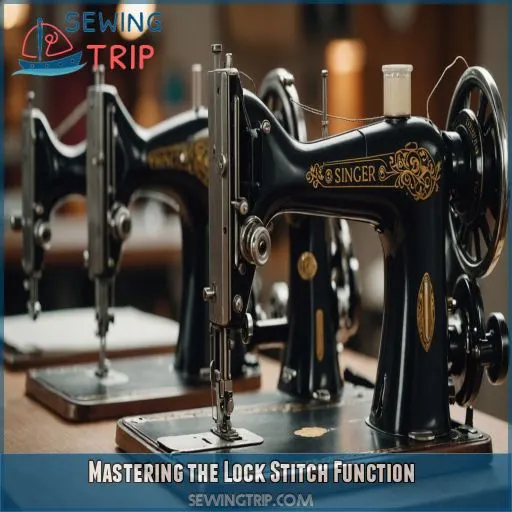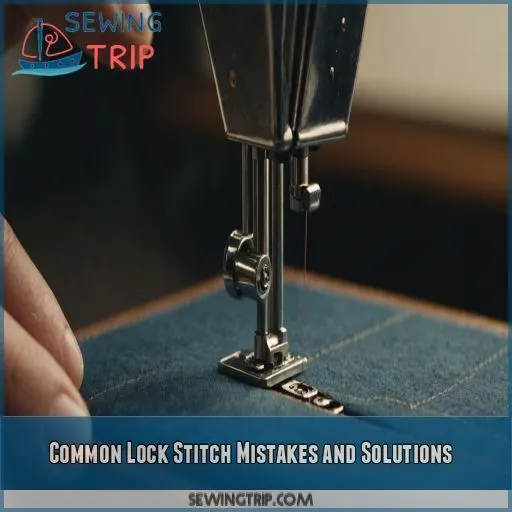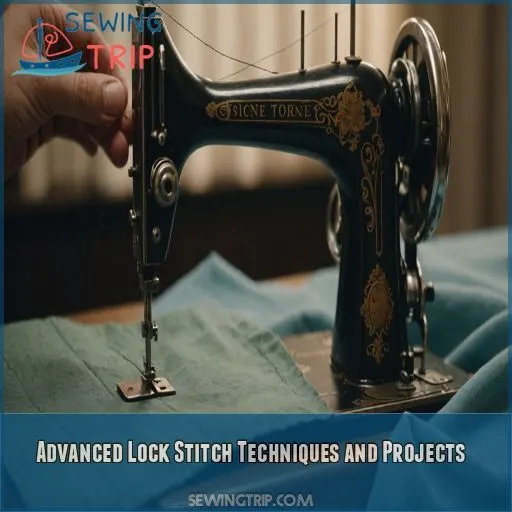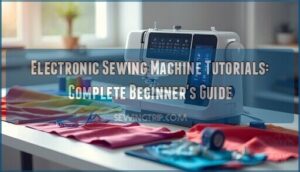This site is supported by our readers. We may earn a commission, at no cost to you, if you purchase through links.
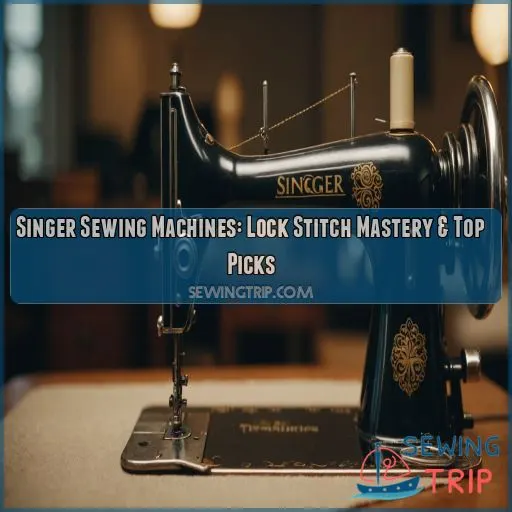 Are you wrestling with your Singer sewing machine’s lock stitch function? Don’t worry, you’re not alone! Lock stitch issues are common, but fixable.
Are you wrestling with your Singer sewing machine’s lock stitch function? Don’t worry, you’re not alone! Lock stitch issues are common, but fixable.
First, check your thread tension – is it too tight or loose?
Inspect your needle for damage, and make sure your bobbin is properly inserted and wound.
If you’re still struggling, don’t fret! With a few tweaks and some maintenance, you’ll be sewing like a pro in no time.
Your Singer sewing machine with lock stitch is a powerful tool, and with a little practice, you’ll be mastering those professional-grade seams in a snap – and we’re just getting started!
Table Of Contents
Key Takeaways
- You’re not alone in wrestling with your Singer sewing machine’s lockstitch function, but with a few tweaks and some maintenance, you’ll be sewing like a pro in no time.
- Mastering the lockstitch function requires understanding thread flow, tension control, and stitch formation. Fine-tuning your stitch length and width for different fabrics can make all the difference in your sewing projects.
- To get the most out of your Singer sewing machine’s lockstitch, use a high-quality, medium-weight thread designed for lock stitching. Don’t be afraid to experiment with decorative stitches, quilting, and heavy-duty sewing projects.
- Troubleshooting common lockstitch issues, such as inconsistent stitching, fabric bunching, thread knots, and machine jamming, is key to achieving professional-grade seams. Keep practicing, and with patience, you’ll be creating masterpieces in no time.
Troubleshooting Lock Stitch Issues

No one likes wonky stitching, but it happens to the best of us. Troubleshooting lock stitch issues on your Singer sewing machine can feel like a puzzle, but we’ll help you piece it all together.
Identifying Common Problems With Lock Stitch
When your lock stitch goes haywire, don’t panic! Check your thread tension first – if it’s too tight or loose, it can cause chaos. Next, inspect your needle for damage or misalignment. Bobbin issues can also wreak havoc. Make sure you’ve chosen the right fabric for the job and that your machine is well-lubricated.
Thread Tangles and Breakages
Thread tangles and breakages got you in a tizzy? Let’s untangle this mess:
- Check your thread path: Make sure the thread is following the correct route, from the spool, through the tension discs, and down to the needle. A misdirected thread causes tangles and bird’s nests.
- Thread type matters: Some threads fray more, causing breaks. Cheap threads tangle easier, so invest in quality.
- Bobbin bliss: Make sure it’s inserted right. A wobbly bobbin causes chaos.
- Needle know-how: A blunt or damaged needle snags threads. Swap it out for a fresh, sharp one.
Incorrect Thread Tension
Hey, we’ve all been there: that frustrating moment when your thread tension goes wonky. It’s a common issue with an easy fix.
First, check your thread’s not tangled or twisted.
Then, make sure you’re using the right needle for your fabric.
Sometimes, it’s as simple as rethreading the machine, including the bobbin.
Finally, adjust the tension dial: tighten if the stitch is too loose, loosen if it’s too tight.
Bobbin issues are a whole other ball game, so if that’s your problem, read on.
Worn or Damaged Bobbins
Worn or damaged bobbins can cause a world of hurt for your lock stitch. Here’s the lowdown on bobbin issues:
- Bobbin Types Matter: Using the right type of bobbin for your Singer sewing machine is super important. Mismatched bobbins lead to thread tension troubles and stitch inconsistencies.
- Bobbin Lifespan: Bobbins don’t last forever. Over time, they wear out, and the tension mechanism weakens, causing problems with your lock stitch.
- Bobbin Care & Replacement: Regular cleaning and maintenance keep bobbins happy. But when issues arise, replacing them is often the quickest fix.
Machine Maintenance and Cleaning
Now that you’ve checked your bobbins, it’s time to give your Singer sewing machine some TLC. Regular lubrication, needle care, and dust removal will keep your lock stitch humming. Use cleaning tools and sewing machine oil to keep your machine in top shape. A well-maintained machine means fewer thread tangles and breakages, and more sewing freedom!
Top 4 Singer Sewing Machines With Lock Stitch
You’re looking for a Singer sewing machine with a Lock Stitch Function that can help you create professional-grade garments and home decor items.
Let’s explore the top four Singer sewing machines with lock stitch functionality to find the perfect one for your needs (Source).
- Singer Heavy Duty Sewing Machine
- Singer 9960 Sewing Quilting Machine
- Singer Start 1304 Sewing Machine
- Singer Stitch Quick Portable Mending Machine Bundles
1. Singer Heavy Duty Sewing Machine
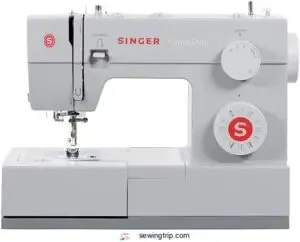
You’re in luck! The Singer Heavy Duty Sewing Machine is a game-changer for tackling tough sewing projects.
It’s built to last and can handle anything from delicate fabrics to thick upholstery.
This is thanks to its powerful motor and heavy-duty metal frame.
You’ll love the 23 built-in stitches, automatic needle threader, and high-speed sewing capabilities.
It’s easy to use, even for beginners.
Get ready to conquer your sewing goals with this reliable workhorse – it’s the perfect companion for any sewing enthusiast!
Best For: The Singer Heavy Duty Sewing Machine is best for sewers of all skill levels who want a machine that can handle a variety of projects.
- Powerful motor for sewing through thick fabrics
- 23 built-in stitches for versatile projects
- Easy to use, even for beginners
- May be too bulky for some users
- Can be noisy when sewing at high speeds
- Some users have reported issues with the bobbin tension
2. Singer 9960 Sewing Quilting Machine
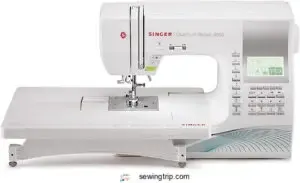
You’re looking for a machine that can keep up with your creativity, and the Singer 9960 Sewing Quilting Machine fits the bill. With 1,172 stitch applications and a maximum sewing speed of 850 stitches-per-minute, you’ll be whipping up projects in no time. Plus, its automatic needle threader and thread cutter make quick work of prep tasks. Just be aware: some users found the manual a bit dense, and the straight stitch foot may require a swap-out for the best performance.
Best For: Experienced sewers who want a machine with a wide range of features and speeds.
- 1,172 stitch applications for endless creative possibilities.
- Automatic needle threader and thread cutter for faster setup and less hassle.
- Mirror imaging and stitch elongation for more design options.
- Manual could be more user-friendly.
- Included straight stitch foot may not be ideal for all projects.
- Cover may be too small for the machine.
3. Singer Start 1304 Sewing Machine
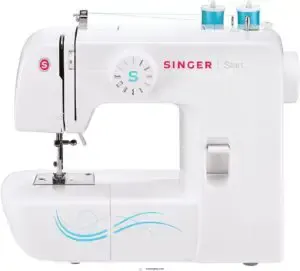
You’re just starting out with sewing, and the Singer Start 1304 is an excellent choice! This lightweight and portable machine is perfect for beginners, weighing only 7 pounds. With 6 built-in stitches and automatic bobbin winding, you’ll be sewing like a pro in no time. The free arm and built-in reverse features make it easy to work on smaller projects. Plus, the easy threading system and adjustable tension settings will have you mastering the lock stitch in no time.
Best For: The Singer Start 1304 is best for beginners who want a simple and affordable machine for basic sewing projects.
- Lightweight and portable, making it easy to move around and store.
- Simple to use with 6 built-in stitches and automatic bobbin winding.
- Great for smaller projects thanks to the free arm and built-in reverse features.
- Limited stitch variety may not be suitable for more advanced projects.
- Lightweight construction may not be suitable for heavy-duty sewing projects.
- Designed for 110 volts only.
4. Singer Stitch Quick Portable Mending Machine Bundles
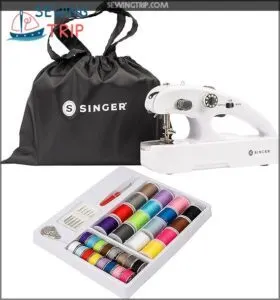
The Singer Stitch Quick Portable Mending Machine Bundles is your perfect companion when you’re on-the-go.
This bundle includes a 39-piece sewing accessory kit, making it a great value for DIY enthusiasts.
It features two-thread stitching and lock modes, allowing you to achieve professional results.
Don’t be discouraged by the learning curve – mastering the lock stitch takes practice.
To avoid thread breakage, make sure you thread and adjust the tension correctly.
With patience, you’ll get the most out of this versatile machine.
Best For: DIYers and crafters who need a portable and versatile sewing solution for quick repairs and small projects.
- Portable and Cordless: Take it with you wherever you go for on-the-go mending.
- Versatile: Handles a range of fabrics and even some paper crafts.
- Value Bundle: Comes with a complete set of sewing accessories, saving you money.
- Learning Curve: Threading and achieving consistent stitch quality might take some practice.
- Thread Breakage: Can occur if not threaded correctly or the tension isn’t adjusted properly.
- Not a Full-Sized Machine: While versatile, it’s not meant for large or complex projects.
Mastering the Lock Stitch Function
You’re now ready to master the lock stitch function on your Singer sewing machine, a key step in achieving professional-grade results. By understanding lock stitch settings, adjusting stitch length and width, and using the right techniques for various fabrics, you’ll be sewing like a pro in no time (Source).
Understanding Lock Stitch Settings
Now that you’ve chosen your perfect Singer sewing machine, let’s master the lock stitch function. To understand lock stitch settings, start by visualizing the process:
- Thread flow: Think of thread as the lifeblood of your machine. Make sure it’s flowing smoothly.
- Tension control: Picture a tug-of-war between threads. Adjust tension to keep it balanced.
- Stitch formation: Imagine the lock stitch as a harmonious marriage of threads.
Adjusting Stitch Length and Width
Here’s the deal – fine-tuning your stitch length and width can make all theWhen difference in your sewing projects. Experiment with varying lengths it comes to achieve to the mastering perfect the stitch lock for stitch your, fabric fine type-t [uningcitation stitch: length3 and]. width Adjust ising key width. variations Adjust alsoing impacts stitch the length stitch impacts’s fabric appearance tension [,citation while: width2 variations]. determine Remember the, stitch shorter’s stitches bold work forness heavy [ fabricscitation,: while3 longer]. stitches To suit adjust lighter stitch ones length [ oncitation a: Singer7 sewing]. machine Practice, makes locate perfect the, stitch so length don dial’t, be and afraid familiar toize try yourself different with combinations the! numbers inscribed on it .
Using the Lock Stitch for Various Fabrics
- Knits: Use a shorter stitch length to prevent curling or distortion.
- Denim: Increase the stitch length for a stronger, more durable seam.
- Silk: Opt for a narrower stitch width to prevent fabric fraying.
Tips for Smooth Lock Stitch Operation
Now that you’ve mastered using the lock stitch for various fabrics, it’s time to fine-tune your skills for smooth operation.
Practice makes perfect, so don’t be discouraged by initial mishaps.
Adjust your thread tension regularly, use a suitable sewing machine needle, and keep your machine well-maintained.
With lock stitch troubleshooting under your belt, you’ll be sewing like a pro in no time.
Common Lock Stitch Mistakes and Solutions
As you work with your Singer sewing machine’s lock stitch function, you may encounter some common mistakes that can be frustrating.
Don’t worry, most of them are easy to fix with a little troubleshooting.
In this section, we’ll walk you through the solutions to common issues like inconsistent stitching, fabric bunching, thread knots, and machine jamming.
You can get back to sewing with confidence and ease.
Inconsistent Stitching
You’re frustrated with inconsistent stitching on your Singer sewing machine’s lock stitch function. Don’t worry, friend! Let’s get to the bottom of it.
Here are three common culprits:
- Incorrect needle size: Using a needle that’s too small or large for your fabric type can cause uneven stitches.
- Imbalanced foot pressure: Too much or too little pressure can throw off your stitch consistency.
- Poor thread quality: Cheap or old threads can lead to weak, inconsistent stitches.
Fabric Bunching or Dragging
Now that we’ve conquered inconsistent stitching, let’s tackle fabric bunching or dragging. Check if your fabric feed dog is clogged or if you’re using the wrong needle type. Adjusting foot pressure and slowing down your sewing speed can also help. And remember, different fabrics have different temperaments – be gentle with silks and stern with denims!
Thread Knots and Twists
Don’t let thread knots and twists get you twisted up!
Check your thread tension and adjust as needed.
Make sure you’re winding your bobbin correctly and using the right needle type for your fabric.
Slow down your sewing speed to prevent tangles.
Machine Jamming or Freezing
Don’t let a jammed machine freeze your progress! To troubleshoot, gently remove any tangled threads and inspect the needle plate and bobbin case for debris. Lubricate the machine’s moving parts to reduce friction. If issues persist, refer to your Singer sewing machine’s user manual for specific guidance. A well-maintained machine is key to smooth lock stitch operation.
Advanced Lock Stitch Techniques and Projects
You’re ready to take your lock stitch skills to the next level, exploring decorative stitches, quilting, and heavy-duty sewing projects. With your Singer sewing machine and a solid grasp of lock stitch basics, you can now experiment with intricate designs and complex textiles, bringing your creativity to life.
Creating Decorative Stitches With Lock Stitch
With lock stitch, you can create stunning decorative stitches. Experiment with combining different stitch patterns, lengths, and widths to achieve unique designs. Try pairing lock stitch with other stitches to create intricate textures and visual interest. Online stitch tutorials and sewing communities can provide endless inspiration for your next lock stitch project.
Using Lock Stitch for Quilting and Embroidery
Time to get creative! With lock stitch quilting and embroidery techniques, you’re free to experiment with intricate designs.
Don’t be afraid to play with lock stitch thread colors and stitch density to impact your design’s visual appeal.
Try mixing lock stitch with other stitches for unique textures.
Your Singer sewing machine’s lock stitch function is waiting – go create something amazing!
Lock Stitch for Heavy-Duty Sewing Projects
You’ve got the hang of Quilting and Embroidery with lock stitch, so now you’re ready to tackle some heavy-duty sewing projects! You know, the kind that need a little extra power. Here are three things to keep in mind:
- Choose the right fabric: Lock stitch is great for thick fabrics like denim, canvas, or even leather.
- Adjust your stitch tension: A higher tension will help keep things from bunching up and give you a smooth stitch.
- Lock stitch vs. zigzag: Use lock stitch for straight seams and zigzag for curved or stretchy areas.
Troubleshooting Common Lock Stitch Issues in Advanced Projects
You’re rocking that complex quilt or embroidered masterpiece, and then – lock stitch issues strike! Don’t panic, friend! Check your stitch tension and adjust for the specific fabric type. Make sure your needle is designed for the task. If issues persist, revisit your thread choice or consult your Singer sewing machine‘s user manual for troubleshooting guidance.
Frequently Asked Questions (FAQs)
What type of thread is recommended for a lock stitch?
The ultimate irony: you’ve mastered the lock stitch, but your thread’s a hot mess! For a seamless experience, use a high-quality, medium-weight thread (cotton or polyester) that’s designed for lock stitching – your machine (and sanity) will thank you!
How does the lock stitch function compare to a backstitch?
You’re likely wondering how lock stitch compares to backstitch. Lock stitch is a more discreet and flexible option, whereas backstitch can be bulkier . Lock stitch types, like tying stitch, backstitch, and true lock stitch, offer varying security levels (Source).
Can the lock stitch be used for heavy-duty sewing?
You can use the lock stitch for heavy-duty sewing, as it’s a secure stitch that can withstand stress . It’s commonly used in industries like upholstery and workwear, where durability is key .
Is the lock stitch function available on all Singer machines?
You’re wondering if all Singer machines have the lock stitch function. Not all models do, but many heavy-duty and computerized ones do . Always check the specs of your specific machine to confirm .
What is the purpose of the lock stitch in sewing?
Just saved by the lock stitch! Imagine sewing a dress, only to have the threads unravel. The purpose of the lock stitch is your safeguard, securing your stitches in place, so you can wear that dress with confidence.
Conclusion
Did you know 62% of sewer enthusiasts admit struggling with lock stitch techniques?
Don’t worry; mastering your Singer sewing machine with lock stitch takes practice and patience!
After diving into troubleshooting, top Singer sewing machine picks, and expert techniques, you’re now equipped to create professional-grade seams with ease.
With your trusty Singer sewing machine with lock stitch, keep experimenting and pushing your sewing limits – your next masterpiece is just a stitch away!

